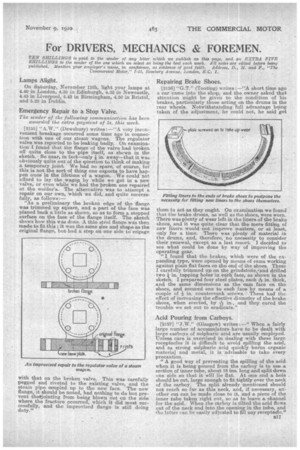For DRIVERS, MECHANICS & FOREMEN.
Page 57

If you've noticed an error in this article please click here to report it so we can fix it.
TEN SHILLINGS is paid to the sender of any letter SHILLINGS to the sender of the one which we select as published. Mention your employer's name, in confidence, Commercial Motor," 7-1,5, Ro which we publish on this page, and an EXTRA FIVE being the best each week. All notes are edited before being as enidence of good faith. Address, B., M. and F., ''The sebery Avenue, London, KZ: 1,
Lamps Alight.
On Saturday, November 13th, light your lamps at 4.40 in Landon, 4.35 in Edinburgh, 4.32 in Newcastle, 4.45 in Liverpool, 4.43 in Birmingham, 4.50 in Bristol, and 5.28 in Dublin.
Emergency Repair to a Stop Valve.
The sender of the following communication has been awarded the extra payvient of 5s. this week.
[2155] "A.W." (Dewsbury) writes :—"A very inconvenient breakage occurred some time ago in connection with one of our steam wagons. The regulator valve was reported to be leaking badly. On examination I found that the flange of the valve had broken off quite close to the pipe itself, as shown in the sketch. So near, in fact—only in. away—that it was obviously quite out of the question to think of making a temporary joint. " We had no spare, of course, for this is not the sort of thing one expects to have happen once; in the lifetime of a wagon. We could not afford to lay the wagon by while we got in a new valve, or even while we hadthe broken one repaired at the welder's.. The alternative was to attempt a repair on our own, which we did, and quite successfully, as follows:—
"As a preliminary the broken edge of the flange was trimmed up square, and a part of the face was planed back a little as shown, so as to form a stepped surface on the face of the flange itself. The sketch shows how this was done. A thin steel flange was then made to fit this; it was the same size and shape as the original flange, but had a step on one side to engage
with that on the broken valve. This was carefully pegged and riveted to the existing valve, and the steam pipe coupled up to the new face. The new flange, it should be noted, had nothing to do but prevent theejointing from being blown out on the side where the fracture occurred, which it did most successfully, and the improvised flange is still doing duty."
Repairing Brake Shoes.
[2158] "G.T." (Tooting) writes :—"A short time ago a car came into the shop, and the owner asked that attention might be given to the condition of his brakes, particularly those acting on the drums in the rear wheels. Notwithstanding full advantage being taken of the adjustment, he could not, he said get
them to act as they ought. On examination we found that the brake drums, as well as the shoes, were worn. There was plenty of wear left in the liners of the brake shoes, .and it was quite clear that the mere fitting of new liners would not improve matters, or at least, only for a time. There was plenty of material in the drums, and, therefore, no necessity to consider their renewal, except as a last resort. I decided to see what could be done by way of improving the operating gear. "I found that the brakes, which were of the expanding type, were opened by means of earns working against plain flat faces on the end of the shoes. These I carefully trimmed up on the grindstone,-and drilled two in. tapping holes in each face, as shown in the sketch. I prepared four steel plates, each.Ain. thick, and the same dimensions as the earn face on the shoes, and secured one to each face by means of a couple of in. countersunk screws. These had the effect of increasing the effective diameter of the brake shoes, when erected, by 1-44in., and they cured the trouble we set out to eradicate."
Acid Pouring from Carboys.
[2157] "J.W." (Glasgow) writes : —" When a fairly large number of accumulators have to be dealt with large carboys of sulphuric acid are usually employed. Unless care is exercised in dealing with these large receptacles it is difficult to avoid spilling the acid, and as strong sulphuric acid quickly burns organic material and metal, it is advisable to take every precaution.
" A good way of preventing the spilling of the acid when it is being poured from the carboy is to use a section of inner tube, about 18 ins, long and split down one side 60 that it will lie flat. At one end a hole should be cut, large enough to fit tightly over the neck of the carboy. The split already mentioned should not reach so far as this neck, and, if necessary,
other cut can be made close to it, and a piece of the inner tube taken right out, so as to leave a, channel for the acid. When the carboy is tilted the acid flows out of the neck and into the opening in the tube, and the latter can be easily adjusted to fill any receptacle."


























































